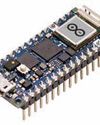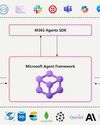Poging GOUD - Vrij
Containers and Virtual Machines: What's the Difference?
Open Source For You
|July 2025
Here's an explanation of what containers and virtual machines are, how they work and compare, and when to use each technology in modern software deployment.

Many people ask, “Is a container just a lightweight version of a virtual machine (VM)?” While that may sound accurate at first, it is not correct.
Containers and virtual machines may seem similar because both help in running applications in isolated environments, but they work in very different ways.
 Teams often rely on these technologies to build, test, and deploy applications efficiently. Virtual machines and containers are powerful tools, but choosing the wrong one for a specific use case can lead to poor performance, higher costs, or security issues.
Teams often rely on these technologies to build, test, and deploy applications efficiently. Virtual machines and containers are powerful tools, but choosing the wrong one for a specific use case can lead to poor performance, higher costs, or security issues.That is why it is important to clearly understand how these two technologies differ. Knowing the differences helps developers, IT managers, and DevOps teams choose the right solution based on the goals of their project.
What is a virtual machine?
A virtual machine (VM) is a software-based environment that behaves like a physical computer. It allows you to run an operating system and applications just as you would on a regular desktop or server. VMs are created and managed using a tool called a hypervisor, which enables multiple virtual systems to run on a single physical machine.
How VMs work: A hypervisor sits between the hardware and the virtual machines. It allocates system resources such as CPU, memory, storage, and network access to each VM. Every VM includes a guest operating system, which is independent of the host system's OS. This allows VMs to run different operating systems on the same physical server.
For example, you can run a Linux VM on a Windows host machine. The hypervisor ensures each VM is isolated and protected from the others, providing a high level of separation. The benefits and limitations of VMs are listed in Table 1.
Dit verhaal komt uit de July 2025-editie van Open Source For You.
Abonneer u op Magzter GOLD voor toegang tot duizenden zorgvuldig samengestelde premiumverhalen en meer dan 9000 tijdschriften en kranten.
Bent u al abonnee? Aanmelden
MEER VERHALEN VAN Open Source For You

Open Source For You
The Role of Open Source in Building Modern Data Infrastructure
It's no secret that open source is emerging as the backbone of modern data infrastructure. Here’s a list of the core open source technologies used to deploy this infrastructure, along with some real-world examples and a brief on why open source matters.
3 mins
December 2025

Open Source For You
The Whispering Machines: How Open Source is Bringing Intelligence to the Tiniest Devices
Built on open source frameworks, TinyML is enabling complex machine learning models to run on the microcontrollers embedded in connected devices, bringing artificial intelligence to the very edge of the network.
3 mins
December 2025

Open Source For You
Setting Up Snort to Secure Your Network
Snort is a popular, open source intrusion detection system that monitors traffic in real time to detect malware. Here’s a detailed explanation of how to set it up on Ubuntu and test it by generating traffic from another system.
7 mins
December 2025

Open Source For You
When AI Meets DevOps to Build Self-Healing Systems
Traditional DevOps, with its rule-based automation, is struggling to work effectively in today’s complex tech world. But when combined with AlOps, it can lead to IT systems that predict failures and solve issues without human intervention.
7 mins
December 2025

Open Source For You
How to Automate Java Code Modernisation
This short guide illustrates that automating Java code modernisation with Python and OpenAI API is not just possible-it's remarkably effective.
5 mins
December 2025

Open Source For You
The Quest to Build a Quantum Computer
The road to large-scale quantum computing is long and hard, with incremental advances paving the way. But the destination is in sight.
12 mins
December 2025

Open Source For You
Job Opportunities: What's Hot in the Cloud Space?
If there's one field that refuses to slow down, it's cloud computing. Even as automation and AI reshape roles, cloud adoption continues to surge. From startups deploying microservices overnight to enterprises migrating decades of legacy systems, cloud remains the engine of digital transformation. For professionals, this means one thing: skills that live in the cloud won't come down anytime soon.
2 mins
December 2025

Open Source For You
Securing Client Identity with Post-Quantum Cryptography
Here's a quick tutorial on how to build a secure, real world client-server model that establishes client identity by using CRYSTALS-Dilithium, a post-quantum cryptography algorithm.
3 mins
December 2025

Open Source For You
Unlocking the Power of Multi-Agent Solutions with the Microsoft Agentic Framework
The Microsoft Agentic Framework is rapidly emerging as a cornerstone for developers, architects, and technology leaders seeking to build dynamic, intelligent systems powered by multiple collaborating agents. In an era where automation, distributed intelligence, and adaptive software are increasingly vital, this framework offers robust tools and features to accelerate the design and deployment of agent-based solutions.
6 mins
December 2025

Open Source For You
Apache Iceberg and Trino: Powering Data Lakehouse Architecture
Apache Iceberg is a cornerstone of any open data lakehouse, providing the transactional foundation upon which highly scalable and flexible analytics can flourish. Along with Trino, it can be used to build a robust, scalable, and high-performance data lakehouse.
4 mins
December 2025
Listen
Translate
Change font size
